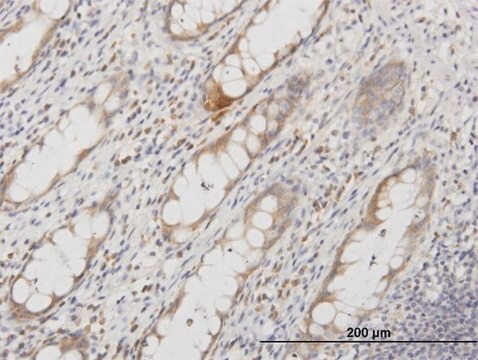A6011
Acetazolamide
≥99%, powder
Sinónimos:
5-Acetamido-1,3,4-thiadiazole-2-sulfonamide, N-(5-Sulfamoyl-1,3,4-thiadiazol-2-yl)acetamide, N-(5-[Aminosulfonyl]-1,3,4-thiadiazol-2-yl)acetamide
About This Item
Productos recomendados
origen biológico
synthetic
Análisis
≥99%
formulario
powder
pKa
7.2
mp
258-259 °C
solubilidad
1 M NH4OH: 50 mg/mL
DMSO: soluble
methanol and ethanol: slightly soluble
cadena SMILES
CC(=O)Nc1nnc(s1)S(N)(=O)=O
InChI
1S/C4H6N4O3S2/c1-2(9)6-3-7-8-4(12-3)13(5,10)11/h1H3,(H2,5,10,11)(H,6,7,9)
Clave InChI
BZKPWHYZMXOIDC-UHFFFAOYSA-N
Información sobre el gen
human ... CA1(759) , CA12(771) , CA14(23632) , CA2(760) , CA3(761) , CA4(762) , CA5A(763) , CA5B(11238) , CA9(768)
mouse ... Car13(71934) , Car5a(12352)
rat ... Car2(54231) , Car4(29242)
¿Está buscando productos similares? Visita Guía de comparación de productos
Aplicación
- to study its protective effect on steatotic liver grafts against cold ischemia reperfusion injury{49)
- to determine its ability to bind isolated porcine retinal pigment epithelium (RPE) melanin by cassette dosing and rapid equilibrium dialysis inserts
- to validate the in vitro gastrulation model of P19C5 stem cells for developmental toxicity screening assays
- to study its inhibitory effect on melanogenesis through enzyme kinetic, in vitro, in vivo and in silico analyses in zebrafish and in A375 human melanoma cells
Acciones bioquímicas o fisiológicas
Palabra de señalización
Warning
Frases de peligro
Consejos de prudencia
Clasificaciones de peligro
Eye Irrit. 2 - Skin Irrit. 2
Código de clase de almacenamiento
11 - Combustible Solids
Clase de riesgo para el agua (WGK)
WGK 3
Punto de inflamabilidad (°F)
Not applicable
Punto de inflamabilidad (°C)
Not applicable
Equipo de protección personal
dust mask type N95 (US), Eyeshields, Gloves
Certificados de análisis (COA)
Busque Certificados de análisis (COA) introduciendo el número de lote del producto. Los números de lote se encuentran en la etiqueta del producto después de las palabras «Lot» o «Batch»
¿Ya tiene este producto?
Encuentre la documentación para los productos que ha comprado recientemente en la Biblioteca de documentos.
Los clientes también vieron
Nuestro equipo de científicos tiene experiencia en todas las áreas de investigación: Ciencias de la vida, Ciencia de los materiales, Síntesis química, Cromatografía, Analítica y muchas otras.
Póngase en contacto con el Servicio técnico










